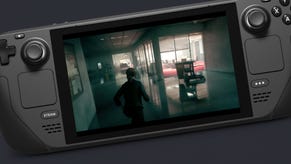Cyberpunk 2077: how the FSR2 upgrade improves visual quality
Patch 1.61 tested on PS5 and Xbox Series consoles.
Cyberpunk continues to get better with every patch. From the bug fixes, the added performance and ray tracing modes on PS5 and Series X, the input lag improvements in patch 1.6, and even Series S getting a 60fps performance mode - the game continues to evolve. Developer CD Projekt RED goes further with the new 1.61 patch, which adds AMD’s FidelityFX Super Resolution, version 2.1, into the game. This is good news for PC owners of course, but FSR2 is also integrated into the console builds too - so what kind of improvement does it bring?
In case this is new to you, FSR2 is a smart upscaling technique designed by AMD, the ideal being to render a good-looking 4K output image using just an internal 1080p image, drastically improving performance in the process. With the move to FSR2, there's an opportunity to adjust the native rendering resolutions on every console. However, in my tests, native resolution targets on consoles generally seem unchanged and dynamic resolution scaling is still in effect. For example, on Xbox Series S' quality mode we have 1440p as the target, though the lowest possible resolution does seem to shift, from the 1296p seen in version 1.6 to 1080p on this new patch.
It's worth stressing that the typical rendering resolution in-between these points on Series S is similar. And likewise Series S' performance mode targets 1080p once again as the maximum possible figure, while for the lowest point in GPU-taxing areas, Series S' performance mode drops closer to 1344x756 - lower than the 800p we recorded before the patch. As for PS5 and Series X? They each continue to run at a constant native 1440p in their ray tracing modes, as before. FSR2 then reconstructs that to appear like a 4K image in static moments, quite convincingly I will say. And in performance mode, the resolution is more flexible, adjusting between 1728p and 1260p.
 Cyberpunk 2077 Patch 1.61: FSR 2.1 Tested on PS5 and Xbox Series X/S - A Big Boost To Image Quality?
Cyberpunk 2077 Patch 1.61: FSR 2.1 Tested on PS5 and Xbox Series X/S - A Big Boost To Image Quality?
The key to patch 1.61's boost to picture quality isn't in those raw pixel counts but in the use of FSR 2.1's image treatment, and there are multiple pros and cons to this. First of all, it's worth pointing out that there isn’t a toggle or an option on console to enable FSR, as there is on PC. Rather, it’s fixed in place, replacing the older default temporal anti-aliasing method CDPR used. Fortunately, in most cases, this really doesn't have a downside. FSR2 does genuinely improve image quality, whether it be in static shots, in motion, in dealing with aliasing, or even in instances of disocclusion - where objects in the foreground move, revealing previously hidden detail.
Taking the 30fps ray tracing mode as an example, the entire image is much sharper and clearer, better resolving sub-pixel detail - and just detail in general. A long view of the outskirts of night city brings this out especially well; more detail is noticeable at range, including the wording on shop signs, and the definition to swaying plantlife. It's not all about enhancing detail, though. FSR2's other strength is in logically recognising the elements of the screen that need to be dialled down. Any elements with visual noise, aliasing, or flicker, need to be addressed - and FSR2 does it more effectively overall - even if it's not entirely eliminated. Indeed in the case of barbed wire fences (see the video above for for detail on this one) sometimes the flickering artfefact looks worse than the older TAAU solution, but ultimately, it’s a net win for image quality.
As for gameplay in motion? Well, here there’s a substantial upgrade to the treatment of fine elements like hair. There's simply less break-up and more temporal stability with the processing FSR2 brings to these finer, sub-pixel details helping to reduce the distraction. FSR2 also thankfully improves - or at least greatly minimises - ghosting artefacts from CDPR’s previous solution. In others words, the obvious banding trails left behind moving objects is reduced, though not totally eliminated.
Fast motion is the ultimate test for upscalers, and yet again, FSR2 manages to boost overall clarity as we walk, or even drive quickly forward. Inevitably there is some break-up to lateral motion, though really, it's to be expected given how FSR2 works. During a panning shot, FSR is being fed new visual data from the screen's edges - and during a rapid pan most of the data within the frame will be entirely different to the last. Even with such limits, Cyberpunk 2077 is still better with FSR2 than without, but moving into performance mode, the internal resolution is reduced and so the impact the algorithm makes is more limited. FSR2 on PS5, Series X and S' performance modes still offers a boost to overall clarity. It's also worth noting that doubling frame-rate to 60fps here gives a temporal-based solution more data to work with, meaning FSR2 has more success in motion in this mode.
Performance bears some mention. We're used to seeing a trade-off between visuals and frame-rate, and so the question is: with all of FSR2's benefits, is there any difference to how PS5 or Series consoles play? The truth is that the consoles always lost most performance in crowded areas - the market for example - with this likely being a CPU bottleneck that will go unaffected by FSR2. And taking PS5 as an example in its 60fps performance mode, that still holds true on patch 1.61. In side-by-sides with our last tested patch - update 1.5 - there's a difference, though not a consistent one. Patch 1.61 sometimes pushes ahead, and sometimes falls behind. Later shootouts do show the new patch dropping more often into the 50fps region. But then, this might be incidental - given gameplay is impossible to sync all the way.
In general, PS5 and Series X, tend to exhibit a similar performance profile on patch 1.61. Drops to 50fps and under are possible, just as they were before. Adding FSR2 isn't helping to clear the gap to a rock-solid 60fps, but evidence suggests it’s not hindering it either. Meanwhile, there is some evidence (around mirrors specifically) that Xbox Series S runs a touch faster with FSR2, though this may well be down to tweaks to dynamic resolution and/or the introduction of AMD’s upscaler. It's not a radical difference and certainly later tests within night city don't make the advantage so obvious. For PS5, Series X and S, the highlight is without question the improved image quality.
Overall FSR2 is a net win for all new consoles, intelligently picking out the details we want enhanced, while also addressing issues with the image, like ghosting on movement and the flickering on hair. There's more stability, fewer distractions, and a greater push for detail at range. The only downside is that algorithm is still work-in-progress, with AMD working to improve the technology even now. Image breakup is still a problem, and in fact, on Series S specifically there's moments where the image momentarily breaks up during basic forward movement. Cyberpunk has come a long way since its launch though. Every new patch - even incremental ones like 1.61 - seem to make an impact, showing that CD Projekt RED is far from done with the game










